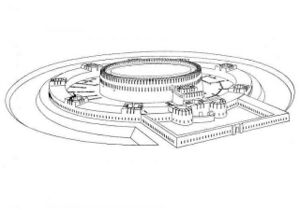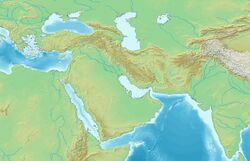Place:Koi Krylgan Kala
 Koi Krylgan Kala (reconstruction) | |
| Alternative name | Koi Krylgan Kala |
|---|---|
| Location | Karakalpakstan, Uzbekistan |
| Coordinates | [ ⚑ ] : 41°45′18.77″N 61°7′1.22″E / 41.7552139°N 61.1170056°E |
| Type | Settlement |
| History | |
| Periods | Parthian, Sasanian |
| Site notes | |
| Excavation dates | 1938 |
| Condition | Ruined |
Koi Krylgan Kala (Uzbek: Qoʻyqirilgan qalʼa; Russian: Кой-Крылган-Кала) is an archaeological site located outside the village of Taza-Kel'timinar in the Ellikqal'a District (Uzbek: Ellikqalʼa tumani; Russian: Элликкалинский район) in the Republic of Karakalpakstan, an autonomous republic of Uzbekistan. In ancient times, it was sited along a canal in the Oxus delta region.
There is some relationship between Koi Krylgan Kala and Toprak-Kala, 30 km to the northwest.[1] It is a temple complex of the Chorasmian Dynasty, an Iranian people who ruled the area of Khwarezm. It was built in the 4th-3rd century BCE.[2] The Apa-Saka tribe destroyed it c. 200 BCE, but later it was rebuilt into a settlement, which lasted until c. 400 CE.[3] It was discovered in 1938 by Sergey Pavlovitch Tolstov, leader of the Chorasmian Archaeological-Ethnological Expedition. It contained a Mazdian fire temple and was decorated with frescos of wine consumption.
The explorer Sergey Tolstov drew a reconstruction of the ancient fortress.[4]
Notes
- ↑ Welcome to Uzbekistan, 1997
- ↑ KIDD, F.; CLEARY, M. NEGUS; YAGODIN, V. N.; BETTS, A.; BRITE, E. BAKER (2004). "Ancient Chorasmian Mural Art". Bulletin of the Asia Institute 18: 77. ISSN 0890-4464. https://www.jstor.org/stable/24049142.
- ↑ Eshan 1983,1136
- ↑ Jettmar, Karl (1967). "The Middle Asiatic Heritage of Dardistan. (Islamic Collective Tombs in Punyal and Their Background)". East and West 17 (1/2): 59–82, Fig. 10. ISSN 0012-8376. https://www.jstor.org/stable/pdf/29755106.pdf.
References
- Yar-Shater, Ehsan (1983). The Cambridge history of Iran. Cambridge University Press. pp. 1488 pages. ISBN 0-521-24693-8. https://books.google.com/books?id=y7IHmyKcPtYC&dq=koi+krylgan+kala&pg=RA2-PA1138.
- Eduljee, K. E. (2007). "Zoroastrian Heritage". Heritage Institute. http://www.heritageinstitute.com/zoroastrianism/khvarizem/page4.htm#koykrylganKala.
 |





